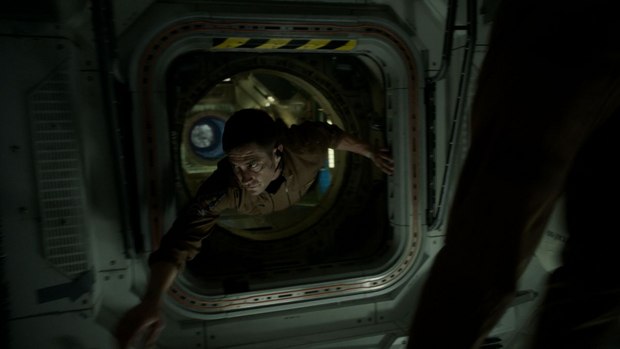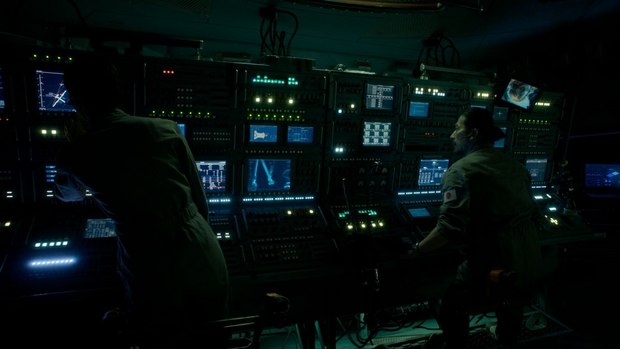VFX supervisor Mark Bakowski discusses his team’s 10,000 frame, seven-minute ISS interior sequence for Daniel Espinosa’s and Sony’s sci-fi thriller.
When a satellite returns from Mars with what appears to be an alien lifeform, the celebratory mood at the International Space Station turns to horror as each of the astronauts become hunted prey with very few places to hide. Life, directed by Daniel Espinosa (Child 44), stars Jake Gyllenhaal, Rebecca Ferguson, Ryan Reynolds, Hiroyuki Sanada, Ariyon Bakare and Olga Dihovichnaya, with visual effects supervised by John Moffatt (Harry Potter and the Half-Blood Prince). ILM was hired to orchestrate the introduction of the ISS orbiting Earth and the different crew members working within spacecraft’s tight confines -- ILM San Francisco handled the 1,000 frame opening shot that establishes the exterior presence of the ISS while ILM London was responsible for a seven-minute long interior ISS sequence that consisted of 10,000 frames and required the stitching together of 17 plates.
“There was an extensive amount of previs and techvis done to start the whole process off so we had a good idea of where we were trying to join shots together and what were the key story points,” explains ILM’s London-based VFX supervisor Mark Bakowski. “Then we worked with John Moffatt to put together a rough version. There was not much in the way of concept art as the ISS and Earth were reasonably realistic builds.”
Though Bakowski’s team had considerable previs at hand, framing and composition of the shots were not entirely predetermined. He notes, “We had joins that involved a character on-screen taken over by a digital double and transitioned to the B plate of a different character. Those joins involved CG environments or at least a reprojection of the plate environment. We had a fair degree of freedom to play with that. Daniel Espinosa was keen to have those as naturalistic as possible. If you were shooting this for real and were following someone down the tight confines of the tunnels in the ISS then space was needed for the cameraman to back up and turn around. We weren’t framed up perfectly with our characters as they go through so there was some dead time and space as we went back to find our hero character again.”
Unlike on Gravity, extensive sets were built for Life. “Three quarters of the ISS tunnels were built practically with the roof removed so that the wire rigs could go down and have access to the actors,” remarks Bakowski. “The interior of the ISS is spartan and feels like a laboratory. We did little touches of dust motes being caught in the light and had glints outside the window. Anytime we could stick a lens flare in we would stick a lens flare in. Some interior lights we gave flares and glints to bring the shot to life. Then there were natural patches of darkness and highlights for range and variety so we weren’t constantly in a florescent light lit office space world.”
The characters’ movements helped the creation of seamless transitions from one plate to another – keeping things interesting was the utilization of a poor man’s motion-control. Says Bakowski, “There were a couple of key moments where we had an in-camera drift with so much parallax that it would have been hard and expensive to rebuild and takeover the camera so we used floating props to justify the movement of the camera.”
Digital human augmentation was required to simulate zero gravity. “We certainly had to repose parts of the body when you could see that the actor was wearing a hip swivel harness,” explains Bakowski. “Their waist would sag so we had to do a bit of warping. There were creases in the clothes, sections where the clothes would ride up and times that the wires went in front of people’s faces. It’s not spectacular work but is still challenging. Another of our challenges was having characters coexisting in the same zero-g environment and making sure there was consistency in the lighting and their momentum. You’ll have characters who would just keep on going until an object forced them to stop, such as an existing bulkhead or a CG version.”
Additionally, user interfaces had to be produced for the visible ISS computer monitors. “For story point purposes, we needed to make it clear that Jake Gyllenhaal’s character was controlling the Canadarm, which catches the satellite. We replaced a few on-set monitors and added some CCTV style exterior views of the Canadarm. We also added a red dot on an exterior map to show where Gyllenhaal was relative to the approaching satellite.”
“We went back and forth [with Moffatt] about how much in the way of stars we would see and how much in the way of artefacts, like lens dirt and glow,” states Bakowski. “Hero images were selected where you could see how the sun bled through the sections of the solar panels while others reflected and refracted light. We cheated the amount of sun moving across the solar panels to make sure that the whole thing came to life rather than looked like a static still frame.” Embellishments were also made to Earth by putting glints onto rivers. Bakowski continues, “Our view of Earth was based on reference photography and time lapse footage from the ISS. We were careful that the sun was behind something such as a solar panel or crane so you would never be looking at it and Earth at the same time; that would have given us an exposure nightmare.”
Along with traditional matte paintings, Terragen was used by Bakowski for the first time to block the lighting positions of Earth. “We did a fair bit of motion vector dynamism to get rid of the worst of the fireflies because when you’re dealing with high contrast space material it can get quite noisy with the light bouncing around. We held our render power back, then kicked out a large render, put that through various compositing processes, and did reprojection here and there to patch it up as required.”
























